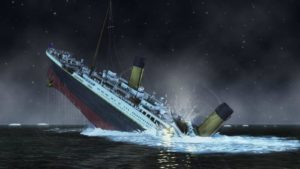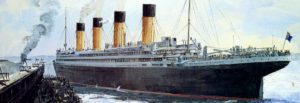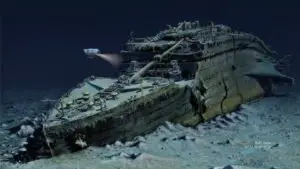
A few days ago the world remembered a huge maritime disaster. In the early hours of April 15, 1912, a British ocean liner sunk into the North Atlantic Ocean about 400 miles south of Newfoundland, (Canada) after hitting an iceberg. More than 1500 out of the 2223 people on board the ship died. It is a tragedy obscured by time and fairly recently brought back to the forefront of the younger generations’ minds by movie director John Cameron and plenty of Hollywood’s magic. The ship’s name? “Titanic”, of course.
Myths and Conspiracies
On April 10, 1912, the RMS Titanic departed from Southampton (England) to New York (USA) for her fateful maiden voyage into history. Many famous and rich people such as John Jacob Astor, Isidor and Ida Straus, Benjamin Guggenheim were on board. Several of them died. One hundred and seven years after the sinking, everything about the tragedy of the ship billed as “unsinkable” by the media, continues to amaze us.
– RMS means Royal Mail Steamer. In formal terms, it also means “Royal Merchant Ship”.
– The Titanic was built at Harland and Wolff Shipbuilding in Belfast, Northern Ireland in 1912. It cost around £1.5 million and took three years to build (and less than three hours to sink). With 880 feet long and 175 feet high the Titanic was the largest ship in the world at the time.
– The Titanic had 2 sister ships, the Olympic, and the Britannic. A conspiracy theory states that the Titanic was swapped with the Olympic and that it has been the Olympic which was purposely sunk as part of an insurance scam. Other proposed causes involve the actions of a back-to-life Egyptian mummy, (known as the “Unlucky Mummy”) and a torpedo from a German submarine.

– An old theory that has been gaining ground for some time now, indicates that the ship did not sink because of its collision with the iceberg. Several experts have come to the conclusion that it a coal fire on the ship, that would have been burning unnoticed for three weeks, before the liner crashed against the iceberg, had weakened the ship’s hull steel so badly that it allowed the iceberg to rip through it easily.
– ‘Futility’, a book written by Morgan Robertson in 1898, fourteen years before the famous shipwreck, foreshadowed the sinking of the Titanic. The plot tells a strikingly similar story: an ocean liner sinks into the waters of the North Atlantic when it hits an iceberg. The most notable coincidence is that the ship in the book was called “Titan”.
– A menu of the day of the disaster was sold for the US $ 115,000 and a violin that was played at the time the ship sank was auctioned off at the almost US $ 1,500,000.
– Millvina Dean was the last survivor of the Titanic. She died in May 2009, at 97. Milvina was a baby of months when her sister and her parents embarked on the third class. They were on the way to a new life in America. Her mother and sister also survived but her father died in the crash.

– Cameron’s take on the iconic star-crossed lover’s theme created one of the most successful movies of the 90s. It also gave the disaster an aura of romance and somewhat morbid glamour. While famous, Cameron’s work is not unique. The story of the ship has been taken to the screen more than a dozen times.
– In 2012, Clive Palmer an Australian multimillionaire and politician announced his plans to build a replica of the ship. In 2018 the project resumed construction after years of stagnation due to financial disputes. Titanic II is expected to commence operations at some point during 2022.
– After the disaster, the White Star Line sent four ships to explore the area: the MacKay-Bennett, the Minia, the Montmagny, and the Algerine. They only recovered 328 bodies over three months. 119 of them were thrown back into the sea. Of the 209 remaining, 150 were not claimed by their relatives and were buried in several cemeteries in Halifax, Nova Scotia. Only 59 were recovered, identified and buried in the traditional way. The rest of the bodies were never recovered.
– On September 1, 1985 oceanographers Robert Ballard and Jean-Louis Michel located the remains of the Titanic. They are 3,800 meters deep. Beginning in 2018, and in 2019, it will be possible for tourists to visit the shipwreck. Unfortunately and according to a 2016 study, due to the action of rust eating bacteria, what remains of the Titanic will likely be little more than a rust spot on the ocean floor by 2030.
– As a result of the sinking, several countries began to monitor the location of icebergs and created the International Ice Patrol. The IIP is in charge of the surveillance of the “Iceberg Alley”, an area of the Atlantic Ocean near the Island of Newfoundland. It is widely accepted that one of the icebergs from the Alley was the one that sank the Titanic. The IIP carries out aerial and radar patrols to mark the danger limits presented by the icebergs and issues a daily bulletin.

– Also as a reaction to this tragedy, in November 1913, the International Convention for Safety of Life at Sea (SOLAS) came into force. Since then, the convention regulates aspects such as life-saving equipment, radio communications, the safety of navigation and ice patrols.
Even though it has been dwarfed by more modern, much bigger and more luxurious ships – the Titanic is still present in the collective imagination of many. At the launching of the Titanic in 1911 93,000 people came to Belfast to see her. Since that night in April, many shipwrecks have occurred with many more victims and nobody remembers them. What has made this ship so different? No one knows for sure but it seems that her “heart will go on” for a long time.

